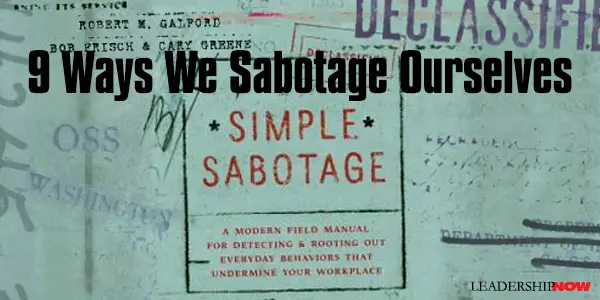 |
 |
02.19.16

9 Ways We Sabotage Ourselves
FROM PEOPLE whose job it is to sabotage the efforts of others, we can take a lesson or two. In Simple Sabotage, authors Robert Galford, Bob Frisch, and Cary Greene explain that in January 1944 the OSS (Office of Strategic Services—predecessor of the CIA) published the Simple Sabotage Field Manual (PDF) to train resistance members in the art of sabotage. “The Manual detailed easy ways to disrupt and demoralize the enemy’s institutions without being detected.” One section of the Manual provided eight tactics specifically designed to disrupt the enemy’s organizations. The authors have added a ninth in keeping with the times. One thing you will notice from each of these tactics or behaviors is that none of them are all that bad on the surface. One could easily find a rational explanation for engaging in them—to a point. And that’s the problem. That’s why these are insidious. Too often we insist on reproducing a behavior long after the sell-by date. We don’t let it go when we should and so we unwittingly sabotage our best efforts. Here are nine acts of sabotage we unintentionally get caught up in: Sabotage by Obedience Insist on doing everything through channels. Never permit shortcuts to be taken in order to expedite decisions. Sabotage by Speech Make “speeches.” Talk as frequently as possible and at great length. Illustrate your “point” by long anecdotes and accounts of personal experiences. Sabotage by Committee When possible, refer all matters to committees, for “further study and consideration.” Attempt to make the committees as large as possible—never less than five. Sabotage by Irrelevant Issues Bring up irrelevant issues as frequently as possible. Sabotage by Haggling Haggle over precise wordings of communications, minutes, resolutions. Sabotage by Reopening Decisions Refer back to matters decided upon at the last meeting and attempt to reopen the question of the advisability of that decision. Sabotage by Excessive Caution Advocate “caution.” Be “reasonable” and urge your fellow conferees to be “reasonable” and avoid haste, which might result in embarrassments or difficulties later on. Sabotage by Is-It-Really-Our-Call? Be worried about the propriety of any decision—raise the question of whether such action as is contemplated lies within the jurisdiction of the group or whether it might conflict with the policy of some higher echelon. Sabotage by CC: Everyone CC: Everyone. Send updates as frequently as possible, including in the distribution list anyone even peripherally involved. In each chapter, the authors use examples to help you identify the behavior and root it out—which is not as simple as you might think. Perpetrators can easily defend their behavior, but that’s what makes these behaviors so effective. For the same reason, it is also difficult to see in ourselves. Simple Sabotage is about the day-to-day routine interactions and processes we rely on as we work that are undermined by unintentional sabotage. By identifying and removing the hundreds or even thousands of small, barely perceptible irritants—the “sand” that clogs the machinery—you will transform your workplace or workgroup experience and the experience of those around you. 
Posted by Michael McKinney at 10:15 AM
|
BUILD YOUR KNOWLEDGE
 

How to Do Your Start-Up Right STRAIGHT TALK FOR START-UPS 
Grow Your Leadership Skills NEW AND UPCOMING LEADERSHIP BOOKS 
Leadership Minute BITE-SIZE CONCEPTS YOU CAN CHEW ON 
Classic Leadership Books BOOKS TO READ BEFORE YOU LEAD |